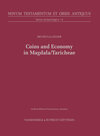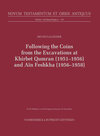
×
![Buchcover ISBN 9783525503683]()
This package contains the publications
Bruno Callegher, Coins from the Excavations at Khirbet Qumran (1951–1956) and Aïn Feshkha (1956–1958), ISBN 978-3-525-50194-8
The Qumran coins (hoard and single finds) are worthy of a novel. They were perfectly examined by H. Seyrig and A. Spijkerman, then the popular conviction spread that the coins had been lost. In fact, they were always kept where they had been classified. Now they are finally published and provide the possibility to suggest that Qumran was a very open centre for trade and transactions, at least from finally the end of the second century BC until the destruction of the site in 70/72 CE.
This documentation provides a new reasoning on effective data – not on assumptions.
Bruno Callegher, From Hasmonean Period to Umayyad Rulers. Coins and economy in Magdala/Tarichea, ISBN 978-3-525-50193-1 On a monetary basis, Magdala must be considered as one of the most important and active settlements between the 1st century BC and most of the 3rd century AD on Lake Kinneret, a place of production and trade, of supply for military forces, certainly in contact with other trading centres, Its monetary decline started on the early 4th century, when the economic and monetary strategies of the Constantinian era shifted the flow of money to other routes, especially between the great port cities of the Mediterranean. Bruno Callegher’s study publishes new data, which allow us to overcome “clichés” and a stereotypical view of both the archaeological site and the economy of the Upper Galilee.
Bruno Callegher, From Hasmonean Period to Umayyad Rulers. Coins and economy in Magdala/Tarichea, ISBN 978-3-525-50193-1 On a monetary basis, Magdala must be considered as one of the most important and active settlements between the 1st century BC and most of the 3rd century AD on Lake Kinneret, a place of production and trade, of supply for military forces, certainly in contact with other trading centres, Its monetary decline started on the early 4th century, when the economic and monetary strategies of the Constantinian era shifted the flow of money to other routes, especially between the great port cities of the Mediterranean. Bruno Callegher’s study publishes new data, which allow us to overcome “clichés” and a stereotypical view of both the archaeological site and the economy of the Upper Galilee.




